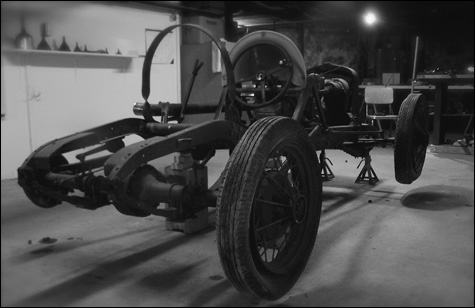
|
The Maine College of Art’s MFA thesis group show, on display at the Institute of Contemporary Art gallery at MECA, rides a questionable line between relevant social critique buoyed by valid critical theory and an egocentric interplay of misplaced postmodern gestures. This collection of completed work from several graduating students, although heavy on the video installations, nevertheless reveals a multiplicity of outcomes from a program designed to challenge the students towards uncharted intellectual and practical depths.
Amanda Proeber’s “Lipscapes” features eight boomboxes placed on plastic-wrapped pillows. Each one plays a track of ambient sounds such that different plops, clicks, slams, and smacks sound at different times. Unfortunately, there is no appropriate place for viewers to immerse themselves. Two video projections are set askew and forced together to create a bowed, lip-like shape. Nebulous close-ups of rosy lips are broken down to movement and color to create a highly emotional effect that is in turn confounded by the squared-off militia of technology providing the images and sound.

Bennett Morris creates a more interactive video installation with “Intercept Station v2.0.” The viewer is buffeted by a concave wall that creates a separate world within the gallery space and displays a large projection with four different surveillance images. War and destruction are assuaged by the Baudrillardian simulacra of Centcom. This advanced stage of removal from the real is emphasized on the convex side of the partition where Morris has positioned several lenses that act as alluring peepholes revealing distorted miniatures of ruined civilization.
John Gayle’s installation involves three large projections onto monoliths of narcissism. The camera follows the artist in close-up as he moves through unpopulated industrial locales. A running interior monologue mutters paranoid diatribes of external and internal expectations, leaving the viewer as frustrated as the artist. Melanie Fiander’s “My Amina,” juxtaposes weak video with strong audio of e-mails lamenting the loss of a loved one. An impersonalized mode of communication is illuminated as the voice lists the CC recipient list and subject with equal weight to the eulogized text. Both these pieces work toward deconstructing ideologies of communication and power but don’t quite allow for the emergence of an elusive third aspect of the dialectic, the diférance, to bring the viewer out of the presupposed hierarchies.
Kate Holcomb’s “Caked” succeeds in delivering this third option. Upon entry, the viewer walks on a hodgepodge floor composed of different levels of tabletops surrounded by walls covered with colorful photographs of multi-colored frosted cupcakes in a bathtub. Chocolate drips from the tiled walls and the cake decomposes into a mealy mass. The barrage of close-ups imply a psychological rupture. Something has happened here and its indefinability provides it power.
A child of the culture industry, Christopher Michael Sullivan deconstructs the image-making process to render transparent the role of artist as agent of the image and the image as dependent on its systems of meaning and dissemination. With “00008.9001:Flag, 2007,” CMS applies the hexadecimal code used in digital imaging onto Old Glory such that the white and red stripes are composed of repeating units of “FFFFFF” and “BF0A30.” The viewer desperately wants to stand back and watch the stars appear from the code imprinted on the blue background, but is confronted with the sublime letdown of a blur, leaving only the awareness of a semiotic system, Roland Barthes’s classic example of the French Flag of colonialism propelled into a hyperreal American digital realm.
Kevin Dacey provides a softer approach to questioning the real with spatially adventurous photographs of museum spaces. The artifacts on display are potentially of interest but are relegated as a component of the totality of reflective glass cases. The meditative space of the gallery is fed back into a hall of mirrors reflecting the cultural past and psychological present.
Jewel Rechsteiner’s “Runoff” performance installation consists of buckets in a circle on the floor. Each bucket is stylishly imprinted with a date and time marking the capture of samples of Portland’s sewage runoff with a little saliva thrown in for good measure. The viewer peers down into each one to see different examples of bacterial growth. This biological experiment creates, somewhat literally, mandalas of shit that reveal our relationship of exchange with nature and its beautiful complexity. We are forced to reconcile the body as membrane and cast our intellectual and cultural pursuits in new light.
Email the author
Ian Paige: ianpaige@gmail.com
Thesis Exhibition for Studio Arts MFA Students | at Institute for Contemporary Art at Maine College of Art, Porteous Bldg, 522 Congress St, in Portland | Through May 25 | 207.879.5742